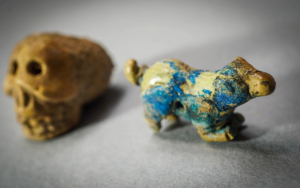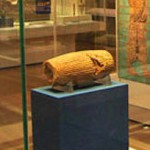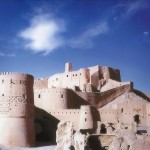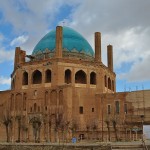 Archaeologists in Pompeii have discovered a treasure trove of good luck charms and fertility amulets which they think may have been used for casting spells by an ancient Roman sorcerer.
Archaeologists in Pompeii have discovered a treasure trove of good luck charms and fertility amulets which they think may have been used for casting spells by an ancient Roman sorcerer.
The collection includes tiny carved phalluses, pieces of bone shaped as human skulls and fists, small bronze bells which would have been rung to ward off bad luck, and scarab beetles made from amethyst.
There are fertility symbols made from turquoise, pieces of crystal and amber beads from a necklace. Archeologists discovered the objects in a horde hidden in a room in the Casa del Giardino, or House of the Garden.
Glass beads are decorated with images of the god Dionysus and dancing satyrs.
The objects included tiny animal figures and a bone carved into a miniature human skull
Experts think the objects may not have belonged to the villa’s wealthy owners because the horde did not include the gold jewellery that they would have expected to have found.
Instead they think the esoteric collection belonged to a low-born Roman or even a slave who used it for casting spells and engaging in rituals linked to fertility, seduction, child birth and marriage.
They said the area in which the trove was found was probably part of the servants’ quarters. These were items “to wear on ritualistic occasions, rather than as a show of elegance,” said Massimo Osanna, the director-general of the archeological site.
They were kept in a wooden chest, the bronze hinges of which survived while the wood has long since decomposed.
Archeologists believe the objects could have been used by a Roman sorcerer to ward off evil and cast good luck spells Credit: Cesare Abbate/EPA/EFE/REX
The precious gems and decorative items were abandoned when the family and their slaves tried to flee the devastating eruption of Mount Vesuvius in AD79.
Many of them, if not all, did not make it – archeologists found the skeletons of 10 people, including women and children. These are objects from daily life and they are extraordinary because they tell the stories of the inhabitants of the city who tried to flee the eruption,” said Prof Osanna.
“What is particularly interesting is the recurring iconography of the objects and amulets, which invokes good luck, fertility and protection against bad fortune.
An archeologist working on a fresco found in a Roman villa in Pompeii Credit: Ciro Fusco/Ansa
“There are numerous pendants shaped like small phalluses, as well as scarab beetles and the skull. We are studying them in order to understand their exact significance and function.”
The objects are to be put on display in Pompeii in the coming weeks.
Archeologists made another surprising discovery in the House of the Garden last year – an inscription which suggested that the eruption of Mt Vesuvius happened in October AD 79, rather than August, as previously thought.
https://www.telegraph.co.uk
/news/2019/08/12/archaeologists-pompeii-find-amulets-charms-may-have-used-roman/















